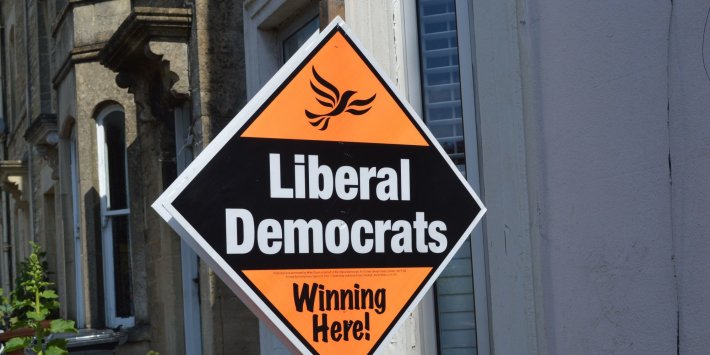
Tactical voting is often central to party campaigning in the run-up to elections (Alamy)
7 min read
As the political landscape in the UK becomes more fractured, some politicians are already worrying about the chaos it could unleash at the next general election.
For example, with an increasing number of viable candidates and parties in contests across the country, traditional tactical voting strategies that some parties have relied on could be upended.
The local election results last week presented a clear victory for Reform UK, which won control of 10 councils, gained two regional mayors, and secured a by-election victory in what was once a safe Labour seat. But it was also good news for the other smaller parties, the Lib Dems and the Greens, who gained more councillors across the country, while Labour and the Conservatives lost councillors overall.
In the run-up to the elections, many of the contests proved complex and unpredictable, with multiple parties in with a chance of victory.
In the race for West of England mayor, the five largest parties received a significant portion of votes, and the Labour candidate won with only 25 per cent. Similarly, in the mayoral election in Cambridgeshire and Peterborough, the Conservative, Reform and Labour candidates all secured more than 20 per cent of the vote.
The results further illustrated that the two major parties could no longer rely on the historic loyalty of voters in once-safe areas.
Four of the last six general elections have seen the combined share for the two ‘big’ parties fall below 70 per cent. At the July general election, it fell below 60. As the UK in a Changing Europe’s Paula Surridge wrote last week, the two-party system is creaking.
The Lib Dems’ strategic dilemma
Some Lib Dems have told PoliticsHome that the shift away from a two-horse race could render their typical campaigning strategy, “We are the only party who can beat [party X],” ineffective.
Thinks Insight research for PoliticsHome after the general election found that a quarter voted tactically to stop a party they disliked from winning. This was highest among people who voted for Ed Davey’s Liberal Democrats, with 40 per cent of these people saying they voted tactically.
“If it’s the end of the two-horse race, how do we make sure we stand out among four or five horses?” one Lib Dem MP said. “Our strategy does need to adapt.”
Another Lib Dem MP described the shift to multi-party contests as “definitely a problem,” but added that it also could open up opportunities for the Lib Dems in new Labour-held areas if the threshold for winning is lowered as a result of there being many viable options.
A senior Lib Dem source told PoliticsHome that they expected tactical voting to still play a role in their campaigns, particularly if voters feel it is necessary to prevent Reform candidates from winning.
Lib Dem candidate Mike Ross came second to Reform’s Luke Campbell in the contest for Hull and East Yorkshire mayor. He said that while the campaign was closely fought, many previous Labour voters did lend their support to him in a bid to keep Reform out. “We’re getting support from people who never thought they’d vote for us, especially those standing up against Reform.”

A confused electoral landscape
As the two-party system weakens, experts have warned that the next election could be one of the hardest to predict in recent history.
Tim Bale, a professor of politics at Queen Mary, University of London, said the shift away from a two-party dominance has been building since the 1970s, but was now “accelerating”. He predicted that MRP polling will become even more difficult to carry out for the next general election.
“For parties, it does present a bit of a challenge, but I think it’s one that they will at least try and rise to,” he continued.
Will Jennings, a professor of political science and public policy at the University of Southampton, said that the increasing complexity of voting behaviour would make it a “huge challenge” for anyone trying to predict results and therefore make tactical voting “really tricky for both parties and voters”.
“This next election is going to be a nightmare, because it’s going to be so fine-grained on such low percentages of the vote,” he said.
He added that the shift towards a four or five-party system will likely force all parties to carefully tailor their strategies to specific constituencies. “The campaign message will change from ‘only the Lib Dems here’ to something more nuanced,” he predicted.
The rise of coalition blocs
The increasingly fractured voting landscape also creates more of an opening for coalition politics. Bale said that a more multi-party system will not necessarily spell the end of tactical voting if contests consist of a ‘progressive’ bloc made up of the Labour, the Greens and Lib Dems, and a ‘right-wing’ bloc made up of Reform and the Conservatives. Voters could still be likely to vote for whichever party they believe most likely to beat the opposing bloc.
-resized.jpg)
There is significant uncertainty here, too, however. While some Conservative voters may be willing to switch to Reform to prevent a Labour government, there are Tory voters who might be unable to countenance the thought of Nigel Farage in Downing Street, and instead look at parties to their left.
Former Conservative chancellor, George Osborne, this week told LBC that the potential rise of Reform UK would not necessarily motivate traditional right-wing voters like himself into alliances with Farage’s party.
Asked whether he could vote for a right-wing group alliance led by Farage, Osborne said: “I would have quite a lot of reservations… I’m verging on no. But I certainly would not vote for Reform.
“My politics is on the centre-right, but the centre bit is as important as the right.”
YouGov polling this week found that 43 per cent of people who intend to vote Tory would be open to a coalition government with the Greens — suggesting it is far from clear that Conservatives would all move as one.
PoliticsHome understands that some figures in Labour believe that if the next election is seen as a battle for power between Keir Starmer and Farage, many Green and Liberal Democrats voters might be more likely to vote Labour to keep Reform out.
However, the view of some Lib Dems is that the struggles of the two major parties could enable the Lib Dems to pitch themselves as the best-placed party to beat Reform in some areas. “I am starting to see it as a duty,” one Lib Dem MP said.
In last week’s elections, there were seven councils and one mayoral contest where Reform and Lib Dems placed first and second – indicating that direct battles between these two smaller parties are certainly not out of the question.
On the other side, in the potential ‘progressive bloc’, there are questions like whether Green voters could be convinced to vote for a Labour Party that they have deemed to have abandoned left-wing causes, even if it is to obstruct Farage.
A unique challenge for the UK
Smaller, populist parties are also on the rise across other countries in Europe, but when trying to predict how this ‘new normal’ might impact voting behaviour, UK parties are faced with a unique challenge.
In countries which have proportional representation, coalitions are often the norm, allowing for more fluid alliances and a broader distribution of power. In contrast, the UK’s system means that fragmentation leads to more unpredictable results, with the potential for the formation of new and unexpected political blocs.
“There aren’t many first-past-the-post systems full stop, or first-past-the-post systems that are so fragmented,” Bale said. “We don’t have many international examples around to draw lessons from.
“Other systems which contain three, four or five parties tend to be obviously proportional representation. So it is quite difficult for parties to think about how they can adapt in the UK.”
While the Lib Dems and other parties may find new opportunities in the changing electoral landscape, the challenge of navigating this new terrain is one that will require careful strategy and flexibility.





